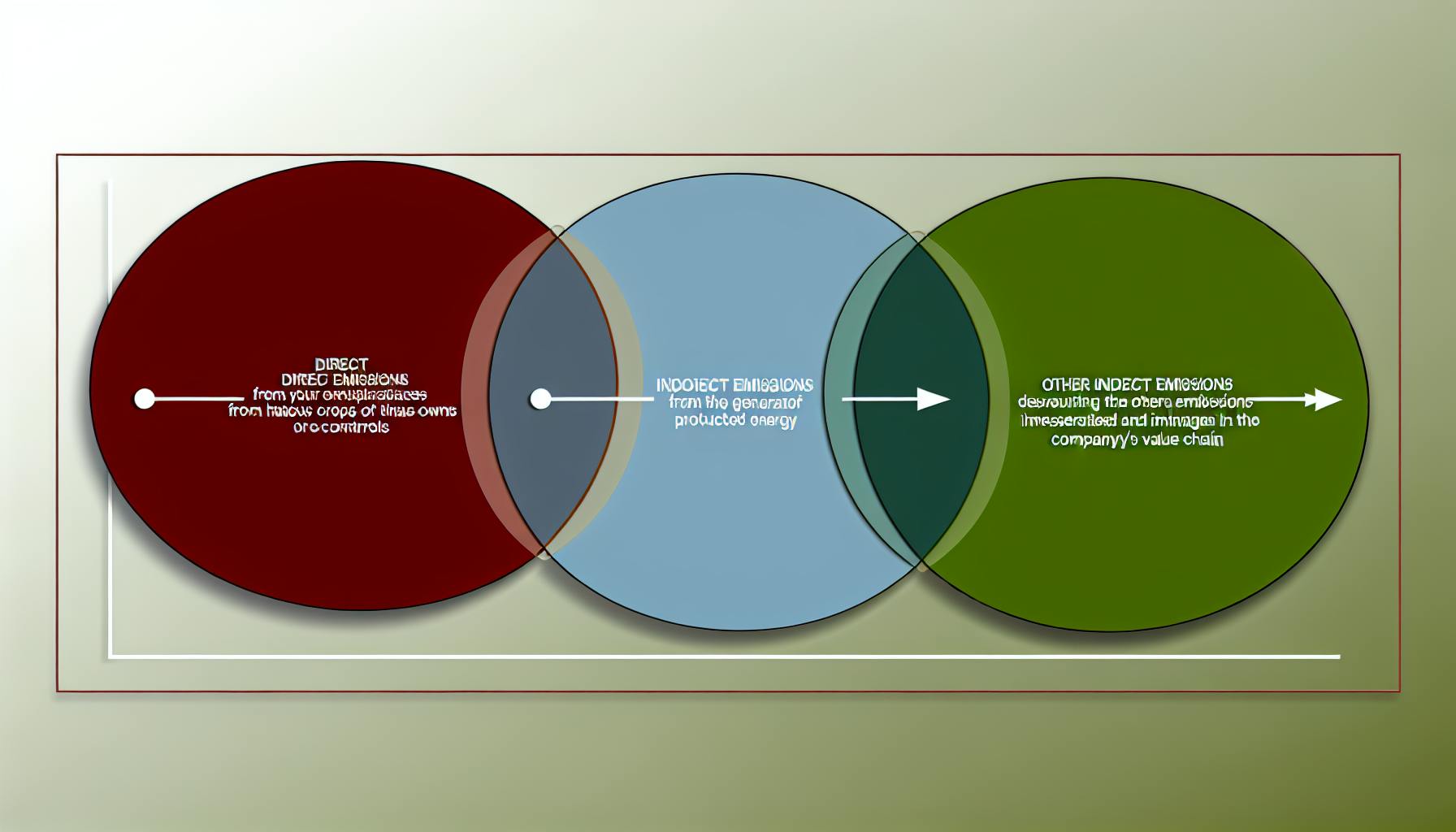Measuring and reporting Scope 3 emissions as part of the GHG Protocol can be a complex endeavor.
However, by following key best practices around calculation guidance, training, target setting, and reporting, organizations can accurately account for and communicate these emissions to enhance transparency.
This article outlines actionable recommendations across the Scope 3 value chain, from collecting granular activity data to defining science-based reduction targets, equipping sustainability teams with a comprehensive playbook for robust GHG inventory management and stakeholder disclosures.
Introduction to GHG Protocol Scope 3 Reporting
Scope 3 emissions refer to indirect greenhouse gas (GHG) emissions that occur in a company's value chain. Measuring and reporting Scope 3 emissions provides a more complete picture of a company's carbon footprint.
What are Scope 3 Emissions
Scope 3 covers all indirect emissions (not included in Scope 2) that occur in the upstream and downstream activities of a company's value chain. This includes emissions from:
- Purchased goods and services
- Transportation and distribution
- Business travel
- Waste disposal
- Use of sold products
- End-of-life treatment of sold products
By assessing Scope 3, companies can identify emission hotspots to focus reduction efforts on.
Why Measure and Report Scope 3
There are several key reasons for companies to measure and report their Scope 3 emissions:
- Provides a more complete and accurate carbon footprint when combined with Scope 1 and 2 emissions
- Allows companies to identify risks and opportunities to reduce value chain emissions
- Demonstrates commitment to stakeholders to address climate change
- Helps companies set science-based targets for emission reductions
- Ensures compliance with emerging disclosure regulations and frameworks
Understanding GHG Protocol Scope 1, 2, 3
The GHG Protocol separates emissions into three categories based on the level of control a company has over those emissions:
- Scope 1 - Direct emissions from owned or controlled sources
- Scope 2 - Indirect emissions from the generation of purchased energy
- Scope 3 - All other indirect emissions from value chain activities
While Scope 3 emissions are challenging to measure, reporting them is vital for enabling value chain decarbonization. Leading companies are increasing transparency by disclosing Scope 3 emissions.
What is scope 3 of GHG Protocol?
Scope 3 emissions refer to all indirect greenhouse gas (GHG) emissions that occur across a company's value chain. According to the GHG Protocol's Scope 3 Standard, scope 3 emissions are a consequence of the activities of the company but occur from sources not owned or controlled by the company.
Some examples of scope 3 emission sources include:
- Purchased goods and services
- Transportation and distribution
- Waste disposal
- Employee commuting
- Investments
- Leased assets and franchises
Reporting on scope 3 emissions provides companies with a more complete view of their carbon footprint. It allows them to identify hotspots for emissions reductions and engage suppliers and partners on sustainability efforts.
However, scope 3 calculations can be complex. Sources are often outside a company's direct control and data may be difficult to obtain. Guidance documents like the GHG Protocol Scope 3 Calculation Guidance outline methodologies companies can follow to accurately measure and report their scope 3 inventory.
Proper scope 3 measurement and reporting is becoming increasingly important. More stakeholders now expect companies to understand risks and identify opportunities across their value chain. Transparent scope 3 disclosure demonstrates commitment to climate action.
What are the 15 categories of scope 3?
The GHG Protocol Scope 3 Standard defines 15 categories of indirect emissions that make up a company's full value chain emissions. Understanding these categories is key for comprehensive corporate carbon accounting and reporting.
Upstream scope 3 emissions
Upstream scope 3 emissions come from a company's suppliers and the purchase of goods and services. This includes:
-
Category 1: Purchased goods and services - Emissions from extracting, producing, and transporting goods and services purchased or acquired by the company. Tools like environmentally extended input-output (EEIO) models can help estimate these emissions.
-
Category 2: Capital goods - Emissions from producing capital goods like equipment, facilities, and machinery purchased or acquired by the company. EEIO models can also estimate these emissions.
-
Category 3: Fuel- and energy-related activities - Emissions from extracting, producing, and transporting fuels purchased by the company that are not included in scope 1 or scope 2.
-
Category 4: Upstream transportation and distribution - Transportation and distribution of products purchased by the company, including transportation between a company's tier 1 suppliers and its own operations.
Downstream scope 3 emissions
Downstream emissions occur later in the value chain and include:
-
Category 5: Waste generated in operations - Disposal and treatment of waste generated from the company's owned or controlled operations.
-
Category 6: Business travel - Transportation of employees for business purposes in vehicles not owned or operated by the company.
-
Category 7: Employee commuting - Transportation of employees between their homes and worksites.
-
Category 8: Upstream leased assets - Operation of assets leased by the company (lessee) in the reporting year and not included in scope 1 and scope 2.
What are the scope 3 categories for GHG?
Scope 3 emissions refer to indirect greenhouse gas emissions that occur across a company's value chain. The GHG Protocol divides these emissions into 15 categories to provide a comprehensive framework for calculating a company's total carbon footprint.
Some of the key Scope 3 categories include:
-
Category 1 - Purchased goods and services: Emissions from extracting raw materials, manufacturing products, and transporting goods purchased by the company.
-
Category 4 - Upstream transportation and distribution: Transportation of purchased goods, products sold to customers, and other upstream logistics activities.
-
Category 6 - Business travel: Emissions from employees traveling for business purposes via planes, trains, cars, etc.
-
Category 11 - Use of sold products: Downstream emissions from products sold by the company during consumer use.
Accurately calculating Scope 3 emissions provides companies with a more complete view of their total climate impact. It also allows them to identify hotspots to target for emission reductions across the value chain. Robust ghg protocol scope 3 reporting and goal-setting enables more meaningful stakeholder engagement and collective climate action.
Which of the 3 scopes used in the GHG Protocol is also known as value chain emissions '?
The GHG Protocol delineates a company's emissions into three categories or "scopes":
-
Scope 1 covers direct emissions from owned or controlled sources like company facilities and vehicles.
-
Scope 2 covers indirect emissions from the generation of purchased energy consumed by the company, like electricity.
-
Scope 3 encompasses all other indirect emissions across a company's upstream and downstream value chain, from suppliers to end-of-life treatment of products.
Out of the 3 scopes, Scope 3 is known as value chain emissions because it accounts for greenhouse gas emissions across the entire supply chain, capturing both upstream and downstream activities related to operations.
Some examples of Scope 3 activities include:
- Transportation of goods in vehicles not owned or controlled by the company
- Business travel in non-company owned vehicles
- Emissions from waste generated from operations
- Use of sold products by consumers
Since Scope 3 emissions often make up the majority of a company's carbon footprint, measuring and reporting them is key to developing a comprehensive and transparent view of emissions impact. The GHG Protocol's Scope 3 Standard provides guidelines to help companies track these extensive value chain emissions consistently.
Accurately assessing Scope 3 allows organizations to pinpoint emission hotspots to address through partnerships, process changes, using low carbon materials, or investing in carbon removal solutions. With stakeholders demanding climate action, focusing on Scope 3 emissions is an opportunity for companies to showcase leadership.
sbb-itb-0f1f828
GHG Protocol Scope 3 Calculation Guidance
Mapping your company's value chain to identify key suppliers, distribution networks, and other partners is an important first step for calculating GHG Protocol Scope 3 emissions. This provides visibility into category 4 upstream transportation and distribution, which can represent a major source of indirect emissions for many companies.
Map your Value Chain Including GHG Protocol Scope 3 category 4
To effectively account for emissions from upstream transportation and distribution (category 4), start by documenting your key suppliers and logistics providers. Gather information on origins and destinations, modes of transport, distance traveled, and weight/volume of goods. This establishes the activity data needed to quantify transportation-related emissions across your extended supply chain.
Potential sources for category 4 activity data include:
- Invoices from logistics companies
- Bills of lading
- Route information from shippers
- Supplier surveys
With this data in hand, you can accurately reflect the climate impact of getting parts, components, and products to your facilities.
Collect Activity Data for GHG Protocol Scope 3 category 1
Purchased goods and services (category 1) often represents the largest Scope 3 emission source. Carefully tracking related spend and supplier details provides the foundation for complete category 1 calculations.
Possible category 1 activity data points cover:
- Spend by supplier
- Categories of purchased products/services
- Production inputs and origin
Leveraging procurement records in combination with supplier engagement ensures you properly capture emissions embedded in the goods and services used by your organization.
Apply Emissions Factors for GHG Protocol Scope 3 category 11
For category 11, encompassing emissions from use of sold products, applying appropriate emissions factors is key. Relevant factors consider:
- Product categories and usage profiles
- Regional electricity emission factors
- Estimated product lifetime/disposal
Robust emissions factors allow translated product specifications and assumptions into quantified GHG impacts from the use phase. For example, the emissions rate per kilowatt hour would provide the factor need to calculate lifetime emissions for sold electronic devices based on estimated energy consumption.
Following GHG Protocol guidelines for category 11 ensures your reporting reflects true downstream usage profiles.
Implementing GHG Protocol Scope 3 Training
Educating employees on GHG Protocol Scope 3 emissions reporting is crucial for companies seeking to improve the accuracy and transparency of their sustainability disclosures. By developing robust training programs tailored to Scope 3 calculations and methodology, businesses can enhance internal capabilities and efficiency.
Develop Internal Training Programs
- Appoint sustainability leads to spearhead the creation of training modules covering Scope 3 fundamentals, calculations, and reporting best practices.
- Conduct lectures and workshops for staff in sustainability, operations, procurement, and finance roles to build cross-functional fluency.
- Create quick video tutorials and self-paced eLearning courses for time-pressed employees.
- Schedule refresher trainings periodically to reinforce learnings and share reporting requirement updates.
Incorporate Scope 3 Standard Principles
- Educate staff on the guiding principles underpinning the Scope 3 Standard, including relevance, completeness, consistency, transparency and accuracy.
- Ensure calculations align with the standard's emphasis on materiality, rigour, consistency and transparency.
- Train procurement teams on quantifying emissions from purchased goods and services per Scope 3 Category 1.
Engage with External Training Resources
- Enroll key staff in GHG Protocol's online courses covering Scope 3 calculations, assessments and goal-setting.
- Attend Scope 3 focused seminars and workshops conducted by reputed sustainability networks.
- Consult reputable consultants to provide specialized Scope 3 training and clarify complex methodological concerns.
Comprehensive Scope 3 training centered around the GHG Protocol Scope 3 Standard can significantly enhance reporting accuracy, transparency and overall emissions management efficacy. An informed, empowered workforce is best positioned to tackle the intricacies of supply chain emissions quantification.
Setting a Scope 3 Reduction Target
Analyzing your company's carbon footprint across all relevant Scope 3 emissions categories, especially category 15 (investments), can uncover the most impactful areas to set a reduction target. This section outlines key steps to take.
Analyze Your Hotspots Including GHG Protocol Scope 3 category 15
- Map your value chain to identify emission sources from upstream and downstream activities. Gather activity data from suppliers and other partners.
- Prioritize high-impact categories by assessing the magnitude of emissions as well as the level of influence your company has.
- Especially take into account category 15 (investments) which can represent a large share of emissions for some companies. Carefully evaluate assets and funds from an emissions perspective.
- Use calculation guidance from the GHG Protocol Scope 3 Standard to reliably quantify emissions for each category. Enlist help from consultants if needed.
Research Mitigation Opportunities
- For key hotspot categories, research viable interventions to reduce emissions, considering costs, feasibility, and stakeholder feedback.
- Strategies may include supplier engagement programs, materials switches, or employee commuting incentives.
- Consult industry associations and peer companies pursuing similar initiatives for insights on overcoming common barriers.
Define Your Target
- Set a specific, time-bound target for lowering Scope 3 emissions, concentrating on hotspot categories.
- Align target level to latest climate science for your sector and stakeholder expectations. Make sure it's ambitious yet achievable.
- Include details on calculation methodologies, target coverage, baseline adjustments, etc. to ensure transparency.
- Commit leadership support and resources needed to meet the target through sustained cross-functional action.
Regularly tracking progress and refining plans based on results will help drive meaningful GHG Protocol Scope 3 reductions while enabling robust internal and external reporting. Reaching an ambitious target requires concerted effort but generates manifold benefits for stakeholders.
Reporting & Communicating Scope 3
Scope 3 emissions can represent the majority of an organization's carbon footprint. Effectively measuring, managing, and reporting Scope 3 emissions is key to developing a comprehensive decarbonization strategy.
Leverage Reporting Frameworks
Using established GHG accounting frameworks like the GHG Protocol ensures consistent and comparable Scope 3 reporting. Some best practices include:
- Align calculations with the GHG Protocol's Scope 3 Standard for accuracy and transparency
- Structure reporting via CDP or GRI for recognized disclosures tuned to stakeholder needs
- Automate data collection from suppliers to minimize manual efforts
Leveraging existing reporting structures can lend credibility and simplify Scope 3 communications.
Respond to Stakeholders
Stakeholders like customers, investors, and policymakers are increasingly requesting Scope 3 disclosures. Some best practices for responses include:
- Proactively communicate Scope 3 emissions and reduction plans, don't wait for information requests
- Tailor messaging and data to resonate with each stakeholder group's priorities
- Contextualize Scope 3 as part of overall decarbonization journey and business strategy
Responsible Scope 3 communications demonstrate awareness of business impacts and sustainability leadership.
Embed in Overall Strategy
Isolating Scope 3 as a separate initiative reduces effectiveness. Integrating Scope 3 management into core business operations enables sustainable transformation via:
- Making decarbonization a company-wide priority with buy-in across departments
- Implementing supplier engagement programs for collaboration on emissions reductions
- Allowing investment decisions and growth plans to account for Scope 3 impact
Embedding Scope 3 into corporate DNA sustains focus beyond reporting into strategy.
Key Takeaways
Scope 3 emissions make up the majority of most companies' carbon footprints. Accurately measuring and reducing these indirect emissions across the value chain is essential for climate action.
Scope 3 Covers Significant Emissions
Scope 3 emissions often represent over 70% of a company's total greenhouse gas (GHG) emissions. For example, an office-based company may only have scope 1 emissions from gas used for heating and scope 2 emissions from purchased electricity. But activities like business travel, waste disposal, and even employee commuting can have a much larger impact. Carefully tracking scope 3 emissions identifies the biggest opportunities to reduce climate impact.
Requires Value Chain Engagement
Scope 3 calculations rely heavily on gathering data from partners across the entire value chain, like suppliers, distributors, and even customers. Open communication and collaboration is key. Companies should provide training and resources to streamline the data collection process. Offering incentives for partners to reduce their emissions can also motivate engagement.
Enhances Competitiveness
Getting a handle on scope 3 positions a company to better manage future risks, uncover efficiency opportunities, and satisfy stakeholder demands. As sustainability regulations and market pressures increase, quantifying scope 3 emissions will soon shift from best practice to competitive necessity. Proactively addressing scope 3 now builds business resilience down the line.


.png)


